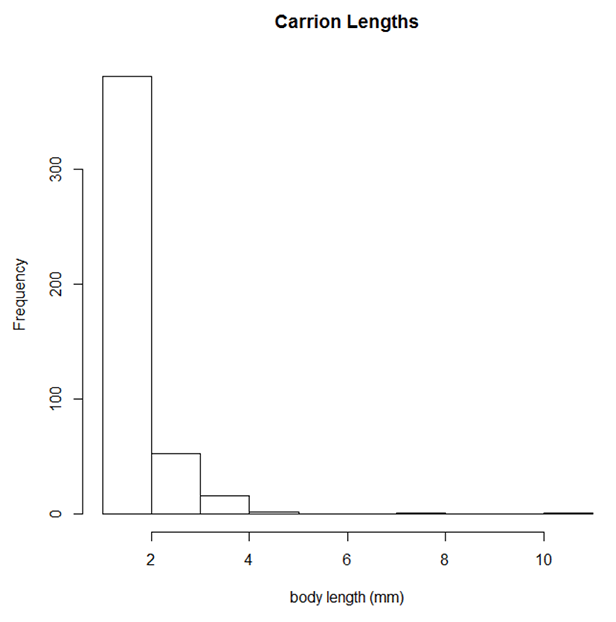
Ecological Archives E096-250-A2
E. F. LoPresti, I. S. Pearse, and G. K. Charles. 2015. The siren song of a sticky plant: Columbines provision mutualist arthropods by attracting and killing passerby insects. Ecology 96:2862–2869. http://dx.doi.org/10.1890/15-0342.1
Appendix B. Entrapped insect data.
We assessed the identity and approximate size of all carrion removed from the first three plants in the carrion-removed treatment on 3 July 2015. We measured all to the nearest millimeter, first with calipers, then estimated by eye. The need to finish counting and instating treatments meant we did this assessment only once. From those three plants, we removed 454 dead arthropods. They had a mean body length of 1.58 ( +0.05) mm, ranging from 1 mm (I did not remove nor assess any arthropods smaller than this) to 11 mm. A histogram of lengths is shown in Fig. B1. Carrion consisted primarily of small flies (Diptera) with lesser numbers of beetles (Coleoptera), wasps (Hymenoptera) and other orders (Fig. B2). Comparable data for Penstemon digitalis (Plantaginaceae) and Cirsium discolor (Asteraceae) are included in Patricia Thomas’s (1988) excellent and quite comprehensive unpublished dissertation and for Vriesea bituminosa (Bromeliaceae) in Montiero and Monceda (2014).
Fig. B1. Frequency diagram of estimated carrion lengths for the 454 assessed arthropods, all orders pooled.
Fig. B2. Frequency diagram of taxonomic affinity for the 454 assessed arthropods.
Literature Cited
Montiero, R. F., and M. V. Monceda. 2014. First report on the diversity of insects trapped by a sticky exudate on the inflorescenses of Vriesea bituminosa Wawra (Bromeliaceae: Tillandsioideae). Arthropod-Plant Interactions 8:519–523.
Thomas, P. A. 1988. The function of insect-trapping by Penstemon digitalis and Cirsium discolor. Dissertation, University of Illinois at Urbana-Champaign, Illinois, USA.